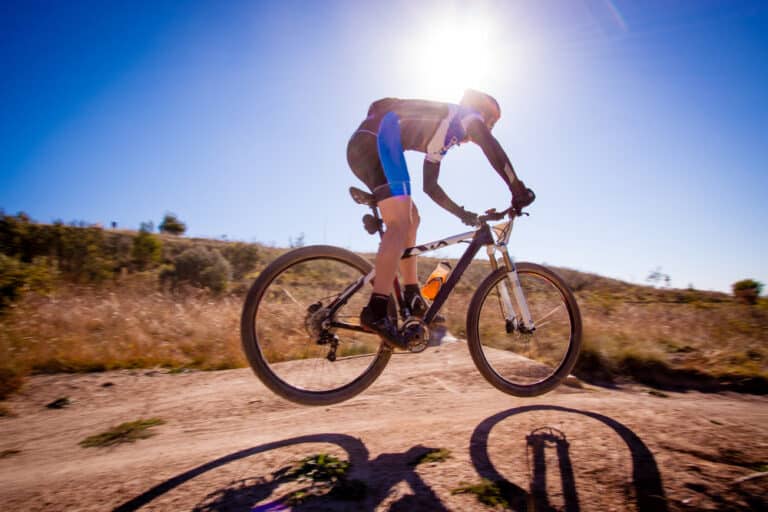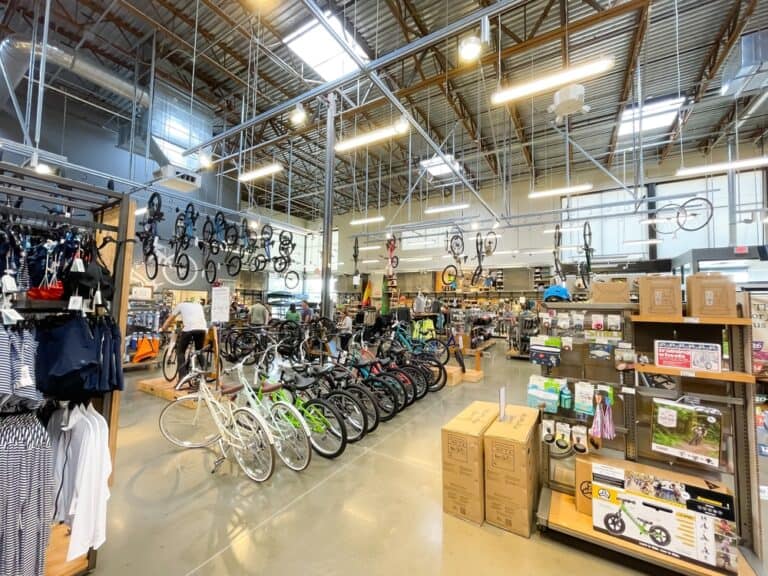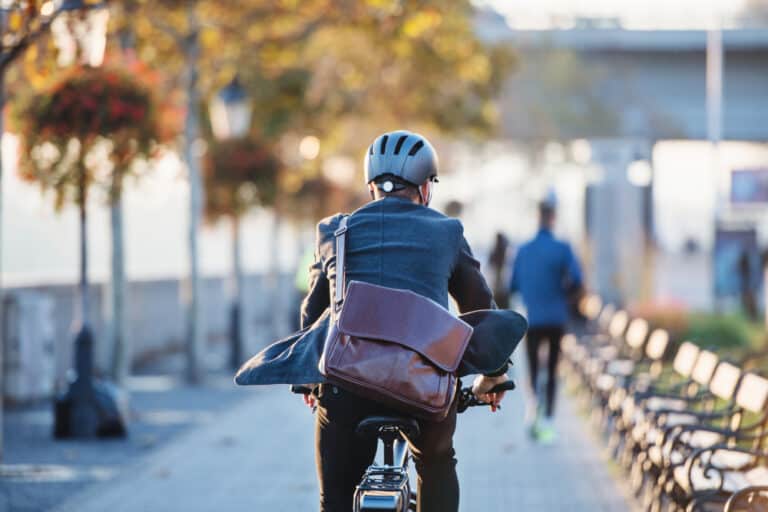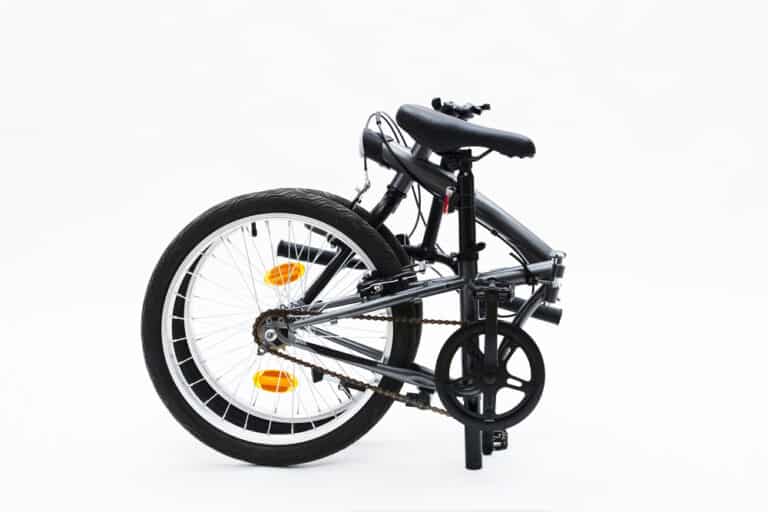Are Road Bikes Slippery?

Staring out the window at the rain, you wonder whether it’s safe to go for a ride. You’ve seen others outside, and although it looks like good fun, it doesn’t seem safe. Those narrow tires look suspiciously prone to slipping if they are wet. But fear not; riding in the rain can be safe and loads of fun.
Road bike tires offer excellent grip on tarmac, even if it rains. The contact between the tire and tar is lessened by rain. However, your breaks will be less effective, and certain parts of the road, such as painted lines, will be slippery. Always take extra precautions when riding in the rain.
You may be tempted to think, “great, so it’s completely safe to ride then.” But that’s not quite the case. Instead, those rainy rides come with a whole set of risks you should know and protect yourself against.
Are Road Bikes Slipper When It’s Wet?
Let’s first address the hardware question: is your road bike slippery when there is water on the road? In other words, is it your bike’s fault that there is less grip in the rain? And are there changes that you can make to your bike to improve it?
Slick Tires Offer More Grip
If you say to a mountain biker that slick tires are gripper than threaded tires, he will probably through his Monster energy drink at you. Because in his world, grip comes from the tread, and slicks mean death.
But, in his world, the roads are loose and move around underneath his wheels. So, his tire treads act like a puppy’s teeth, desperately trying to bite onto its favorite toy, which is being ripped out of its mouth.
However, your tarmac roads are unwavering and unyielding sheets of sandpaper. In other words, in your case, the teeth are on the floor. Also, because your grip comes from the tar, you want as much rubber contact with it as possible.
This means that riding with treated tires will likely take away grip, and you’re better off riding with slicks with more rubber contact with the tar.
Road Bikes Don’t Hydroplane
“But formula one cars use treated tires in the rain!” I hear you shouting at me through your computer screen. Of course, even motorbikes use treads in the rain, but that still doesn’t mean you should.
I shouldn’t have to point out that there is a significant difference in speed between a formula one car and you grunting up a slope in granny gear. And it’s in this speed difference where the secret lies.
Cars, motorbikes, trucks, etc., typically do much worse in the rain. This is because they reach speeds where the tires lift slightly. And then, they start to ride on top of the thin film of water instead of the tar. This is known as hydroplaning, and, as you can imagine, it is fantastic if you’re driving a boat but not a car.
Tires have treads that can fling the water film away and keep in contact with the tarmac to avoid this hydroplaning effect.
Your typical road bike simply can’t go fast enough to hydroplane. In fact, even if you could reach optimal speed, there needs to be more tire surface area to hydroplane. Instead, road bike tires naturally cut through the water.
If you strictly ride only on tar, you are better off using slick tires. But, if you like to wander from the straight and narrow to some off-roading sections, you better use treads.
Your Brakes Are Slippery When Wet
Going speed racing in the rain is only a good idea if you can stop whenever you want. But, as your wheel rim and brake pads get wet, your ability to brake effectively becomes a little questionable. Simply put, bicycle brakes are less effective in the rain.
This is especially true for rim brakes or “V” brakes. Fortunately, hydraulic disc brakes are a lot better at dealing with wet conditions and continue to offer good stopping power. If you live somewhere, like the UK, where it rains a lot, consider upgrading to disc brakes.

Are The Roads Slippery When They’re Wet?
Now that you know the advantages and limitations of your bike, the next logical consideration is the road.
Be Wary Of Older Roads
Modern tarmac roads are generally excellent at dispelling water. However, on older or poorly built roads, there may be areas where the water has pooled. Avoid these pools at all costs if you are going at speed.
It’s not that you will slip if you hit one; it’s that the sudden change from a road puddle could send you flying off your bike. That puddle could also be a deep pothole if it’s an old, unkept road. Hitting one at speed could cost a rim if you’re unlucky.
Another danger of back country roads is that there is typically quite a bit of dirt and debris, which can make you slip. Fortunately, heavy rain is excellent at washing this debris and oil away.
Be Wary Of Lines And Manholes
If you are riding on a wet road, you want to stick to riding on the black tarmac as much as possible.
One of the biggest threats to cyclists and motorcyclists is any painted portion of the road. Painted lines, chevrons, crossing, etc., are ludicrously slippery when wet, especially if the paint is new.
Trust me, you want to avoid riding on those lines as much as possible or risk your bike becoming a bobsled.
The second threat on the road surface is the steal manhole covers. Metal is generally bad at offering grip. And if you add a little water into the mix, those covers become even nastier.
People Can’t See You When It’s Raining
The best advice I got when riding motorcycles was that I alone was responsible for myself. I alone chose to ride a bike, so I need to take responsibility and ride in a way that protects myself.
One thing that you learn quickly on a bike is that cars don’t see you. This is even worse if you are on a pedal bike. Unfortunately, this effect is at its very worst when it’s raining.
If you leave your house on a bicycle, remember that you are doing it at your own risk. You chose to be on that bike, knowing full well that other people cannot see you, so don’t expect them to.
The best defense is this: treat every car like an obstacle that can’t see you and ride accordingly. Also, wear the brightest kit and stack your bike with enough lights to make people think you’re a moving Christmas tree: this generally helps a bit.
Slow Down When It’s Raining
Your visibility is also reduced in the rain. That fact, along with your less effective brakes, means you should lower your speed in the wet. You may need more time to spot and brake for an obstacle in the road, which may cause your ride to end abruptly with a free trip in an ambulance.
Just slow down a bit to give yourself some room for error.
Conclusion
Road bike tires aren’t more slippery when it’s raining outside because the tarmac maintains a good grip. However, the painted lines and manhole covers on the road can be extremely slippery, and your brakes are also less effective. So instead, slow down when you’re riding in the rain, and remember to wear bright clothes.
References
- https://www.bridgestonetire.com/learn/maintenance/hydroplaning/
- https://bicycles.stackexchange.com/questions/1029/is-it-safe-to-ride-a-racing-road-bike-in-very-wet-weather
- https://www.quora.com/Are-slick-bicycle-tires-more-slippery-in-the-wet
- https://www.roadbikerider.com/how-can-i-ride-safely-on-wet-roads-d1/
- https://roadbikeaction.com/why-slick-road-tires-have-the-most-traction/
- https://bikeeastbay.org/wetweather







